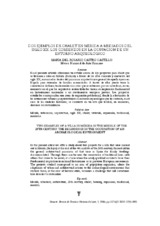Dos ejemplos de chalet en Mérida a mediados del siglo XX: los comienzos en la ocupación de un entorno arqueológico
Two examples of a villa in Mérida in the middle of the 20th century: the beginnings in the occupation of an archaeological environment
Autor
Castro Castillo, María del Rosario
Editor
UCOPressFecha
2016Materia
Mérida (Badajoz, España)Urbanismo
Arquitectura
Siglo XX
Chalet
Vivienda
Expansión
Tradicional
Moderno
Merida
Urbanism
Architecture
20th century
Housing
Expansion
Traditional
Modern
METS:
Mostrar el registro METSPREMIS:
Mostrar el registro PREMISMetadatos
Mostrar el registro completo del ítemResumen
En el presente artículo ofrecemos un estudio acerca de dos proyectos para chalet que se llevaron a cabo en Mérida (Badajoz) a finales de los años cuarenta y cincuenta del siglo XX, enmarcados dentro del panorama arquitectónico general de aquella época en España para viviendas de familias acomodadas. A través de ellos puede verse la coexistencia de líneas tradicionales con otras que se esfuerzan por ser novedosas, en un momento en el que los arquitectos recién titulados tienen su inspiración fundamental en historicismos nacionales o en movimientos europeos previos. Los proyectos estudiados corresponden una zona de expansión poblacional, donde la adecuación de las actuaciones urbanas y arquitectónicas al entorno arqueológico que las sustenta, en el caso de las ciudades históricas, se convierte en un reto que tardará, en ocasiones, decenios en materializarse. In the present article we offer a study about two projects for a villa that were carried out in Mérida (Badajoz) at the end of the 40s and 50s of the 20th century, framed within the general architectural panorama of that time in Spain for family dwellings Accommodated. Through them can be seen the coexistence of traditional lines with others that strive to be novel, at a time when the newly qualified architects have their fundamental inspiration in national historicisms or in previous European movements. The projects studied correspond to an area of population expansion, where the adaptation of urban and architectural actions to the archaeological environment that sustains them, in the case of historic cities, becomes a challenge that will sometimes take decades to materialize.

